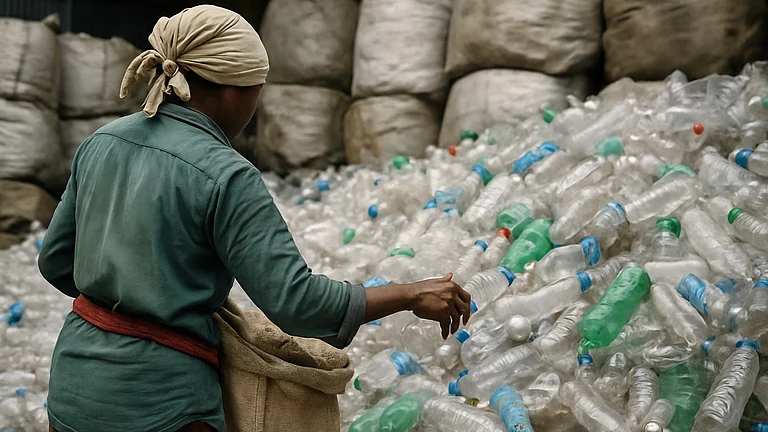A recent study identified India as the world’s leading plastic polluter, generating a staggering 9.3mn tonnes of plastic waste annually. A significant portion of this waste never reaches a recycling facility. Instead, it clogs our drains, litters our landscapes and ends up in landfills or water bodies.
Why Material Recovery Facilities Are the Missing Link in India's Plastic Battle
India's recycling system is broken not at the source, but at the backend—without MRFs, segregation and collection efforts will keep failing
India’s plastic problem is not just about the sheer volume we produce or consume—it's about how little of it is recovered, processed and recycled effectively.
While policies and campaigns increasingly promote source segregation, a fundamental question remains: do we have the infrastructure to manage segregated waste once it’s collected?
Most citizens are reluctant to segregate their waste because they don’t see a visible, functioning system in place to support it. Waste bins are often co-mingled, dry waste isn't picked up separately and when it is, there’s no guarantee it will be handled correctly.
The issue isn’t just behavioural—it’s systemic. We are asking people to segregate without providing the back-end infrastructure to make that segregation meaningful.
Unsung Heroes
At the heart of this missing infrastructure lies a critical, yet often overlooked, component: material recovery facilities (MRFs).
MRFs are the unsung heroes of the recycling ecosystem. These facilities sort, clean and prepare recyclables for further processing—acting as the vital bridge between waste collection and actual recycling.
While public discourse focuses heavily on reducing consumption and encouraging segregation at source, it frequently misses the next, crucial step. Without well-designed, operational MRFs, even the most well-intentioned efforts at segregation and collection are bound to fall short.
What India urgently needs is operational MRFs that are scalable, tech-enabled and seamlessly integrated into a circular economy model. Only then can we truly “close the loop” on plastic waste.
MRFs have the potential to revolutionise India’s fragmented waste management ecosystem by creating a structured and traceable flow for recyclables. These facilities can:
● Maximise resource recovery: Clean and accurate segregation at MRFs enables more plastic and other materials to be recycled, reducing dependence on virgin resources.
● Reduce landfill burden: Proper sorting keeps recyclable waste out of landfills, cutting down environmental degradation and methane emissions.
● Create green jobs: MRFs serve as local employment hubs, especially when developed in partnership with the informal sector, ensuring fair wages and better working conditions.
● Enable data-driven circularity: Digitised MRFs offer valuable insights into waste flows, helping producers, municipalities and recyclers optimise operations and ensure compliance.
● Foster social inclusion: By integrating informal waste workers into the formal waste economy, MRFs can offer safer, more dignified livelihoods.
● Support EPR compliance: With stricter extended producer responsibility (EPR) rules, MRFs can function as verified collection and processing points for brands aiming to meet regulatory mandates.
Technology is a game-changer in the evolution of MRFs. Smart sorting systems, real-time waste tracking, automation and data analytics can drastically improve the transparency, efficiency and accountability of recycling operations.
Digital tools help monitor waste inflows and outflows, identify bottlenecks and ensure traceability across the supply chain. For producers, these tools support EPR tracking. And for processors and recyclers, they provide the data needed to run leaner, more effective operations.
Tipping Point
Despite their importance, MRFs rarely feature in urban planning or investment discussions. Traditional MRFs face a host of challenges: material contamination, inconsistent waste flow, lack of digitisation and poor integration with informal workers. To address this, we need collaborative efforts across public and private sectors.
Strategic investments, clear policy mandates and strong public-private partnerships can help overcome these barriers. As cities grow smarter, it’s imperative that MRFs evolve in tandem. Smart cities need smart MRFs—tech-enabled, well-funded, equipped with the right infrastructure and seamlessly integrated—to truly become cleaner, more sustainable and liveable.
Simply collecting plastic waste won't solve the problem. What happens—after collection—is what truly defines circularity.
India’s plastic crisis requires sustainable systems that treat plastic waste as a resource. MRFs play a key role in shifting from a linear “take, make, dispose” model to a circular economy where plastic is recycled and reused—allowing us to unlock its full value.
If India is serious about meeting its sustainability goals, it must move beyond awareness campaigns and start building the infrastructure that enables real impact. Scalable, tech-enabled MRFs should no longer be an afterthought—they must be central to our waste management strategies.
As we approach World Environment Day, the global theme of “Beating Plastic Pollution” is a timely reminder that change is possible, but only if we address the root of the problem. For India, that means recognising, supporting and scaling MRFs as the missing link in our recycling chain.
The future of recycling—and indeed, of sustainable urban living—depends on creating systems that are robust, transparent and inclusive. Only then can we truly transition from a plastic-dependent economy to a circular one.
The author is co-founder and chief executive at ReCircle. (The views expressed are personal.)


